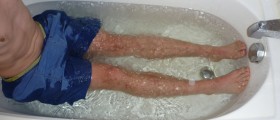What To Do When You Are Suffering from a Fever?
A fever — an increase in your normal body temperature to the point where the thermometer shows results above 98–100°F or 36–37°C (note: results will vary depending on how you take your temperature) — is a typical sign of an underlying infection. As your immune system launches an effort to fight the infection off, your body temperature also rises.
Fevers are not pleasant. Once you start having a fever, you are not able to do anything, due to the fatigue, chill and often general signs of weakness and malaise.
When you have a fever, all you want to do is cover yourself in blankets and wait for the fever to disappear, or alternatively take some fever reducers, like Tylenol or paracetamol.
Could you possibly imagine yourself taking a cold shower or a bath in such a condition? Well, you may have heard that this can help you fight your fever greatly.

The Logic Behind the Idea of Using Cold Baths or Showers to Reduce Your Fever
It seems simple enough; when you have a fever, your body temperature has increased. Wouldn't anything that cools your body temperature down externally — like a cold bath or shower — reduce your fever, too? Well, yes. This is why lukewarm baths and showers can feel quite nice when your body temperature is running hot. If you are feeling weak, a bath is a safer option than a shower, so that you do not have to stand up.
Beware, however. If the water is too cold, you will start experiencing chills and feeling cold. This reaction is due to your body's reaction to a suddenly colder temperature at the surface of your skin, and you can start shivering. Shivering is a mechanism that helps the body increase its temperature when it gets too cold.
Using showers or baths that are too cold to reduce your fever, or your child's, can therefore be counterproductive and even dangerous. Once you begin to shiver, your temperature can peak to the point where your fever is higher than before you attempted to bring it down with a cold bath or shower.
Different Types of Baths for Fighting Fevers
Sponge baths are one of the best ways of lowering one's temperature. They are excellent for babies and people who cannot bathe on their own. All you need to do is fill the bathtub with smaller amounts of lukewarm water and, once immersing the sponge in and squeezing the extra water out of it, rub it onto the skin of the person having a fever. This is guaranteed to reduce his or her body temperature and so lower fever.
Alternatively, if you can manage bathing on your own, you might consider indulging into a bathtub full of pleasantly warm water. Go inside and stay in the tub until the water turns colder, to the point of being lukewarm. Then, you may either refill the tub with warm water or finish your bathing sequence and dry yourself with clean towels. Either way, your temperature will decrease and your fever will likely vanish.
According to some folk tales, putting wet socks on babies is especially effective for reducing fevers — and this can work for older children and adults, too.

















Your thoughts on this
Loading...